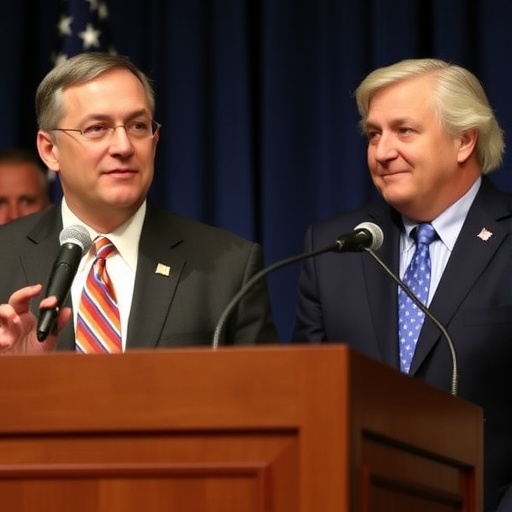Doug Mastriano Hints at Pennsylvania Gubernatorial Comeback, Blasts GOP as Stacy Garrity Revs Up Her Campaign
In a stunning twist to Pennsylvania’s already heated political landscape, Doug Mastriano, the controversial 2022 Republican nominee for governor, has reignited speculation about a potential return to the race. As state Treasurer Stacy Garrity officially launches her bid to unseat Democratic Governor Josh Shapiro in 2026, Mastriano‘s sharp criticisms of the GOP signal deepening divisions within the party. This development could reshape the Republican primary and influence the battleground state’s future direction.
- Mastriano’s Defiant Stance on a Gubernatorial Rematch
- Garrity’s Strategic Launch Targets Fiscal Conservatism
- GOP Internal Rifts Exposed by Mastriano’s Broadside
- Shapiro’s Shadow Looms Over the 2026 Race
- Polling Early and Endorsements Shaping the Primary Battlefield
- Implications for Pennsylvania’s Political Future
Mastriano’s Defiant Stance on a Gubernatorial Rematch
Doug Mastriano, a retired Army colonel and state senator known for his staunch conservative views, has never shied away from controversy. His 2022 gubernatorial campaign, which ended in a decisive loss to Josh Shapiro by nearly 15 percentage points, was marked by endorsements from former President Donald Trump and allegations of election denialism tied to the January 6 Capitol riot. Despite that defeat, Mastriano appears undeterred, recently telling supporters at a Franklin County event that he’s “seriously considering” another run for Pennsylvania governor in 2026.
“The fight isn’t over,” Mastriano declared, emphasizing his belief that the GOP establishment failed to back true conservatives in the last cycle. Sources close to the senator indicate that Mastriano has been quietly gauging support through grassroots networks, particularly among Trump-aligned voters who make up a significant portion of Pennsylvania’s Republican base. In 2022, Mastriano captured about 42% of the vote, outperforming expectations in rural counties but struggling in suburban areas like those around Philadelphia and Pittsburgh.
His potential re-entry into the Pennsylvania gubernatorial campaign isn’t just personal ambition; it’s a direct challenge to the party’s direction. Mastriano has criticized GOP leaders for what he calls “RINO infiltration,” referencing Republicans In Name Only who he believes watered down the party’s platform. This rhetoric echoes his post-2022 reflections, where he blamed internal sabotage for his loss, claiming that national party funds were withheld due to his unorthodox campaign style—relying heavily on social media and avoiding traditional debates.
Political analysts note that Mastriano’s appeal remains strong in the state’s conservative heartland. A recent Franklin & Marshall College poll showed that 28% of Pennsylvania Republicans still view him favorably as a potential leader, higher than many establishment figures. However, his polarizing image—stemming from bans on social media platforms like Twitter (now X) for promoting election conspiracies—could alienate moderates crucial for a general election victory.
Garrity’s Strategic Launch Targets Fiscal Conservatism
While Mastriano mulls his options, Stacy Garrity, Pennsylvania’s first female state treasurer, has wasted no time propelling her own gubernatorial campaign forward. Garrity, a York County native and Army veteran, announced her candidacy last week in Harrisburg, framing her bid around themes of fiscal responsibility and economic revival. “Pennsylvania families deserve a governor who treats the state budget like their own household finances—no waste, no bailouts,” Garrity stated during her kickoff rally, which drew over 500 attendees waving signs emblazoned with “Treasurer to Governor.”
Garrity’s tenure as treasurer since 2021 has been a cornerstone of her pitch. Under her watch, the office managed a $40 billion investment portfolio, achieving a 5.2% return in fiscal year 2023—outpacing inflation and bolstering the state’s rainy day fund to record levels. She has championed initiatives like expanding access to unclaimed property funds, returning over $200 million to rightful owners last year alone. These accomplishments position her as a pragmatic conservative, appealing to voters weary of Shapiro’s progressive policies on education and infrastructure.
Her campaign strategy emphasizes unity within the GOP, contrasting sharply with Mastriano’s combative tone. Garrity has secured early endorsements from key figures, including former U.S. Representative Scott Perry and business leaders from the Pennsylvania Chamber of Business and Industry. Fundraising has been robust; her team reports raising $1.2 million in the first quarter, outpacing initial projections. Garrity’s platform includes tax cuts for small businesses, school choice expansion, and cracking down on opioid trafficking—issues that resonate in Pennsylvania’s rust belt regions hit hard by economic decline.
Yet, Garrity faces her own hurdles. As a relative newcomer to statewide politics, she lacks Mastriano’s name recognition among hardline conservatives. A Morning Consult survey from early 2024 pegs her favorability at 35% among Republicans, solid but not dominant. Her launch event highlighted military service parallels with Mastriano, but experts predict she’ll pivot to differentiate by focusing on governance experience over ideology.
GOP Internal Rifts Exposed by Mastriano’s Broadside
Mastriano’s criticisms of the GOP have struck a nerve, exposing fractures that could define the 2026 primary. In a pointed interview with a conservative podcast, Mastriano accused party insiders of “selling out to the swamp,” specifically naming the Republican State Committee for prioritizing electability over principles. He pointed to the 2022 cycle, where the national GOP’s $10 million investment in Pennsylvania races largely bypassed his campaign, funneled instead to Senate hopefuls like Dr. Mehmet Oz.
This infighting isn’t new to Pennsylvania politics. The state, with its 19 electoral votes and swing status, has long been a battleground for ideological purists versus pragmatists. Mastriano’s 2022 nomination, won through a low-turnout convention rather than a primary, alienated moderates and led to what some called a “suicide mission” against Shapiro. Now, as Garrity courts the establishment, Mastriano’s barbs could splinter the base. “If Doug runs, it’ll be a MAGA vs. Main Street showdown,” observed G. Terry Madonna, a veteran pollster at Franklin & Marshall.
Statistics underscore the stakes: Pennsylvania Republicans hold a slim edge in voter registration (3.5 million vs. 3.4 million Democrats as of 2024), but turnout in gubernatorial races favors Democrats in urban centers. Mastriano’s critique has prompted responses; state GOP chair Lawrence Tabas issued a statement urging “party unity to defeat Shapiro,” while hinting at Mastriano’s potential as a “valuable asset” if he tempers his approach.
Other potential candidates, like state Senate President Pro Tempore Kim Ward and U.S. Rep. Dan Meuser, are watching closely. Ward, who chaired Mastriano’s 2022 effort, has remained neutral but praised Garrity’s “fresh energy.” The GOP‘s ability to coalesce will be tested at the summer state convention, where delegate battles could foreshadow primary dynamics.
Shapiro’s Shadow Looms Over the 2026 Race
Governor Josh Shapiro’s popularity adds another layer of complexity to the unfolding drama. Elected in 2022 with a 15-point margin, Shapiro boasts approval ratings hovering around 55% according to a June 2024 Quinnipiac poll. His administration has touted achievements like a $14 billion infrastructure investment via the American Rescue Plan and property tax relief for seniors, positioning him as a formidable incumbent whose shadow will influence any successor bid.
Democrats view Shapiro’s term as a blueprint for continuity, with Lt. Gov. Austin Davis and state Attorney General Michelle Henry already floating their hats for the Democratic nomination. For Republicans like Mastriano and Stacy Garrity, the challenge is framing Shapiro as out of touch on issues like crime and education costs. Pennsylvania’s K-12 funding crisis, exacerbated by a state Supreme Court ruling, has seen Shapiro propose $1.1 billion in new aid, which critics like Garrity decry as insufficient without reforms.
The gubernatorial race also intersects with national trends. With Trump eyeing a 2024 rematch, Pennsylvania’s gubernatorial campaign could serve as a proxy for MAGA influence. Mastriano’s Trump loyalty—evidenced by his attendance at a 2023 Mar-a-Lago event—contrasts with Garrity’s more measured tone, potentially splitting endorsements. Fundraising data from the Federal Election Commission shows GOP small-dollar donors favoring Mastriano-style candidates, while PACs lean toward Garrity’s profile.
Broader context includes Pennsylvania’s economic pressures: unemployment at 3.6% masks regional disparities, with manufacturing jobs down 5% since 2020. Both candidates have pledged to revitalize the energy sector, though Mastriano advocates for unchecked fracking while Garrity emphasizes balanced environmental regulations.
Polling Early and Endorsements Shaping the Primary Battlefield
Early polling offers glimpses into the race’s trajectory. A hypothetical GOP primary matchup in a July 2024 Spotlight PA survey showed Garrity leading with 32%, Mastriano at 25%, and Ward at 18%, with 25% undecided. These numbers reflect Garrity’s momentum from her launch but highlight Mastriano’s enduring base—particularly in the state’s 67 counties outside major metros, where he won 60% in 2022.
Endorsements are flowing: Garrity has locked in support from the Pennsylvania Manufacturers’ Association, citing her pro-business record, while Mastriano boasts backing from the conservative Pennsylvania Family Institute. Trump’s potential involvement looms large; his 2024 Pennsylvania victory margin was just 1.2%, underscoring the need for unified GOP efforts.
Campaign logistics are ramping up. Garrity’s team plans 20 town halls by year’s end, targeting swing counties like Bucks and Montgomery. Mastriano, meanwhile, is leveraging his 100,000-strong email list from 2022 to build a war chest, aiming for $5 million by primary season.
Implications for Pennsylvania’s Political Future
As the 2026 election approaches, the interplay between Mastriano‘s insurgency and Stacy Garrity‘s establishment push could determine the GOP‘s viability against Shapiro’s Democrats. A fractured primary risks handing Democrats an advantage in this purple state, where independents—numbering 1.2 million—often decide outcomes. Victory for either Republican would signal shifts: Mastriano’s win might embolden national populism, while Garrity’s could herald a return to fiscal conservatism.
Looking ahead, key milestones include the February 2025 filing deadline and summer debates. Voter turnout projections estimate 4 million participants, with mail-in voting expansions post-2020 playing a pivotal role. For Pennsylvania, the stakes extend beyond the governor’s mansion to legislative control and U.S. Senate races, making this Pennsylvania gubernatorial campaign a microcosm of America’s divided politics. Observers predict a bruising primary, but one that could ultimately forge a stronger GOP contender—if unity prevails.
Stay tuned as developments unfold; the Keystone State’s political saga is far from over.








